Michael Walters
Notes from the peninsula
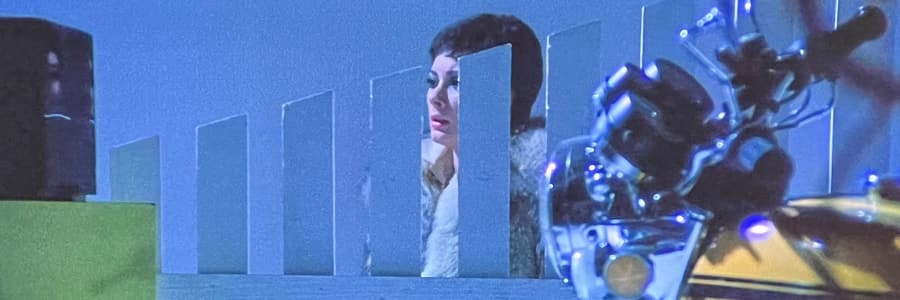
Director: Andrea Bianchi
A hard left turn down an alleyway into a softcore giallo. This might be a spoiler, but the killer did not require anyone to “strip nude”, although there is a tremendous amount of sleazy sex, admirably straightforward nudity, and comically leering men. Sometimes the algorithm wears you down, and the familiar cover art catches you in a vulnerable moment, and you choose a film that you know will be bad… except it’s good!
God, the men are awful in this film, but the characters all work for a seventies fashion agency, so this was probably not far from reality. A woman dies of a heart attack while having an illegal abortion and two men make it look like she died in her bath at home. That night a killer in black motorcycle leathers and helmet kills the doctor, then begins to systematically dispatch everyone at the agency where the dead woman worked.
Each character gets some time to shine, and much comeuppance is had alongside the sex. The male protagonist is a dreadful human being, and I kept asking the beautiful, smart woman working with him (the luminescent Edwige Fenech) why she found him so attractive, but it was probably the same reason I kept watching this film — it’s never dull, there’s always an interesting angle, and it’s endless eye candy.
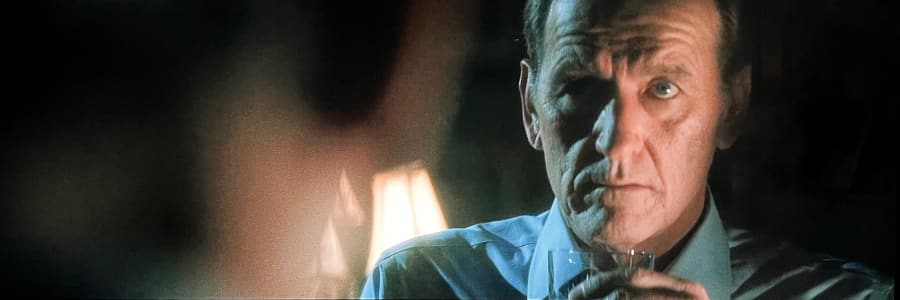
The Broken (2007)
Director: Sean Ellis
Doubles and clones are endlessly interesting. But as exquisite as the cinematography is in The Broken, and as electric as Lena Headey is in the lead role — I could watch her walk moodily around dark London apartments all day — the pacing tested my patience.
The McVey family have a birthday gathering for widower patriarch John at his London apartment. After he tells a grim story involving swapping lubricant for superglue, he gives an end-of-meal toast, and a mirror falls off the wall smashing on the floor. Over the coming days each person at the party is visited by a cold-hearted döppelganger that breaks through a mirror in their home to replace them.
It has an interesting premise that doesn’t feel fully developed, but there are some excellent kill scenes. Dark versions murder the real. X-rays reveal the reverse of what should be. Intimacy is in short supply. The camera pans slowly around empty spaces, shadows are left in the frame after characters have left it, and there are startling moments as the doppelgängers step into the light.
I can’t quite figure out what the story is supposed to mean. John is a US ambassador, lonely, misses his dead wife, and seems traumatised by his children surprising him for his birthday. The lubricant-superglue anecdote brings laughs to the table, but is seriously unpleasant and is the inciting incident to the whole film. Is it to illustrate their darkness and make them worthy of the mirror people’s arrival? Maybe. He seems broken, but most of the others aren’t, so is he visiting his brokenness on them? Who knows?
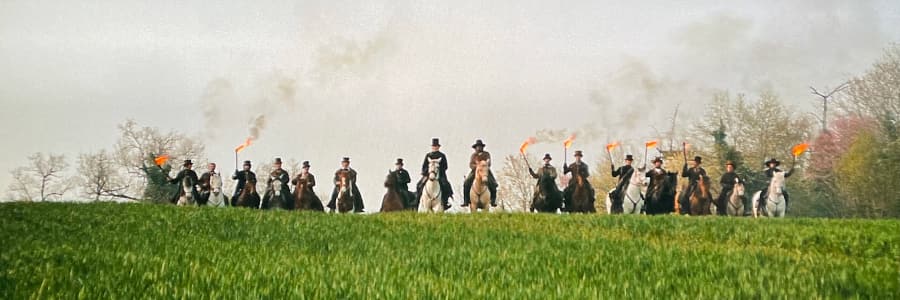
The Cursed (2021)
Director: Sean Ellis
I thought I recognised the face of the mother in A Haunting in Venice, but I didn’t expect it to be Kelly Reilly from Eden Lake, which is (terrifyingly for me) fifteen years old. She’s the link to The Cursed, where a Venice palazzo is replaced by a remote estate in nineteenth-century rural England, and her children are now haunted by a twitching scarecrow and a flying crone.
It opens with a land dispute between rich gentry and a group of travelling Roma families. The gentry hire mercenaries to massacre the Roma, which is beautifully and grimly shown in a single shot from a distant hill. Expecting trouble, the Roma matriarch has prepared a curse involving a set of silver teeth which she then puts on the land. Over the coming weeks, everyone in the nearby village has the same dream, and a creature begins to pick people off. There’s a bite-spread virus and some interesting twists on the werewolf legend.
A visiting pathologist brings some outsider energy to things, but it’s a slow, artfully shot, occasionally visceral and violent pseudo-slasher with excellent acting and impeccable period costumes. There’s lots of time to look at the actors faces. I’m terrible with faces. It seems to take me more time than most to embed a face in my memory. Actors are the worst because they deliberately look different every time. I lose myself in films, so I’m saying to the person next to them, oh look, it’s x from y. The characters are the characters, and I’m IN IT WITH THEM. Anyway, now I know Kelly Reilly’s face.
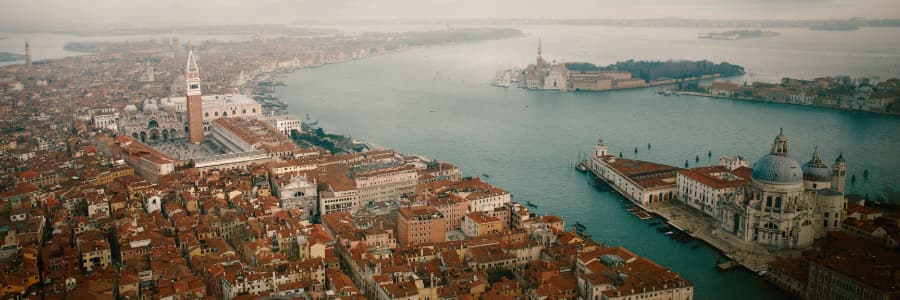
Director: Kenneth Branagh
I ummed and ahhed about this year’s #31DaysofHorror because life is particularly hectic this year, but as frivolous as it might seem, the project is one of the few that is just for me, so I’m going in again. I started with a classic whodunnit, an adaptation of Agatha Christie’s 1969 novel Hallowe’en_Party, which Branagh has shot through a horror genre lens. It’s set in 1947, so the characters are still traumatised from the Second World War. Hercule Poirot has retired to Vienna. It’s playfully shot, with fish eye lenses, hand-held cameras, spooky children and Viennese masks all building a distinctive mood.
This was my third visit to Venice in three months: Mission Impossible: Dead Reckoning in July, Saving Venice in August (a BBC documentary about saving Venice from the damage of rising tides), and now this. Venice’s buildings and bridges and alleyways scream history, and the labyrinthine walkways and squares, overlooked by windows, balconies and rooftops, suggest someone always watching. The water, dirty water from the sewers, regularly floods the streets. Venice is old, filthy and rich.
A Haunting in Venice opens with Poirot being harassed in a quiet, opulent city, then pivots to a single palazzo, an old orphanage, on a stormy night, sealed off from the world. It’s fun, and a mystery, so I’ll say no more.
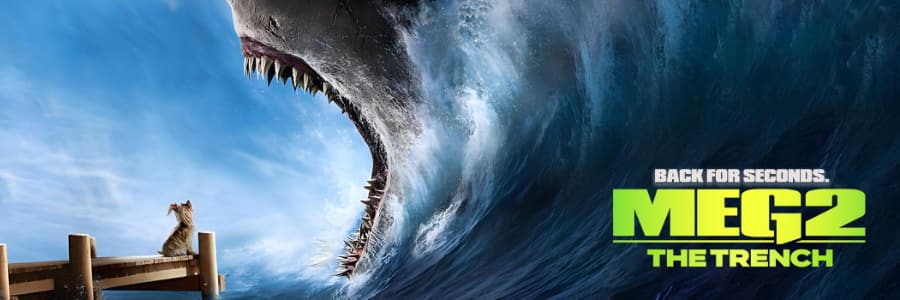
Meg 2: The Trench
The first Meg was fine, but I admit to being more excited this time around because Ben Wheatley was at the helm. His filmography is a string of pearls: Kill List, Sightseers, A Field in England, High Rise, Free Fire, Happy New Year Colin Burstead, Rebecca, and In the Earth. They’re not all brilliant, but he’s always interesting. His best films are made with his partner, Amy Jump. Her name is not in the writing credits of Meg 2.
Monsters escape the deepest recesses of the ocean when greedy humans breach the protecting boundary. Teeth and tentacles chomp, devour, squeeze and rip through submarines, boats, research stations, and eventually a holiday resort. People die. Lots of people having fun die. I found myself laughing because the creatures are ridiculous, partly because it’s clear they are CGI, but also in their relentless, pounding rage at all living things. It’s a relief to see that part of me expressed on screen. Who doesn’t sometimes want to grind the world up, swallow it all down and pass out in a carb coma?
Anyway, I’m not recommending Meg 2: The Trench. It’s a stupid film with terrible dialogue, clichéd story-telling, annoying characters, and a clear eye on the money, but I went with my son, and he enjoyed it, and I enjoyed seeing it with him. That’s the sort of film it is.

Everyman
Got a nice little string of blog posts going here. Here are the May headlines:
- my father is out of hospital (eight weeks!)
- the cinema finally opened
Dad’s bounced back well. He looks his eight-eight years, and he’s anxious about his heart, but he’s happy to be home, able to make meals and potter around the house, and he’s back to sending me the occasional wry message. I’m starting to relax and let in some joy and relief. I just want him to enjoy whatever time he has left.
The new cinema was announced in 2019, and I’ve been boring everyone around me about it ever since. A monthly membership lets me-plus-one watch unlimited films, but in the opening week I was faced with Fast X (shit), The Little Mermaid (not for me), Guardians of the Galaxy 3 (possibly fun, but IP-driven nonsense) and Super Mario Bros (um). This was not how it was supposed to go.
There are throwback showings on Sunday evenings. Last week it was Heat. During the final chase, I could feel the rumble of planes in my stomach, and my wife now has the hots for nineties Pacino. He’s a very sloppy kisser on a big screen. It was all unexpectedly intimate. I’ve become used to television-sized screens for films. Last night it was Fight Club, and they gave out free wine and popcorn. What a film, but, you know, we all know the first rule.
Author speculation
I’m reading Cinema Speculation, Quentin Tarentino’s non-fiction celebration of key American films of the seventies, from Bullitt and Dirty Harry, to Escape From Alcatraz and The Funhouse. I heard about it through the Pure Cinema podcast, which is connected to Tarentino’s Los Angeles cinema, the New Beverly. The prose voice is exactly how Tarentino sounds in interviews and podcasts. I’m sceptical of his writing ability, and I admit to being cynical about his novel, Once upon a Time in Hollywood, published after the film came out.
Obviously, I’m jealous. I don’t doubt his intelligence or capacity to speak fluently about the stories in his head. It’s easy to imagine him walking around his plush L.A. mansion, talking into his phone, then emailing the recordings to a ghost writer who edits them into shape. And why not? Writing clearly happens in many ways.
It feels like cheating because I have fixed ideas on how writers should write. There has to be suffering, each sentence sweated over, whole chapters thrown away, the entire thing rewritten multiple times. There has to be a crisis of confidence and real risk of the whole thing, perhaps even the writer’s life, collapsing into a meaningless void. That’s real writing.
Yes, that’s fucked up. I don’t know anything about Tarentino’s writing process. He’s an impressive artist and this is all in my head. I’m being a dick, and not to Quentin Tarentino, who couldn’t care less. I’m being a dick to myself. This is how I keep me in my place.
Puzzles
At the start of the day a deployment of code went awry and at the end I was a go-between over my still-hospitalised father’s boxer shorts. Life can be ridiculous.
On Monday I went to see John Wick 4 and ate a terrible hot dog. The person serving sprinkled it with dried (!), crunchy onions. Then yesterday I watched the first half of Michelangelo Antonioni’s La Notte. The two films serve different parts of me. Michelangelo Antonioni — I am Michael, my uncle was an Anthony who is now with the angels. He was rich, although he might have denied it. Our last conversation was an argument over Brexit. I told him it would cost the country untold damage, and we’d be back in the EU eventually. He made some argument about the unfairness of laws on unpasteurised French cheeses. It’s a sad memory.
My new work account is the mobile app of a well-known supermarket. On the train home I read A Study in Scarlet, my first Sherlock Holmes novel. All I could see in my mind were Benedict Cumberbatch and Martin Freeman as Holmes and Watson. I need some sleuthing skills to unpick some work puzzles, but first I need to discern the important ones. Not all puzzles are created equal. (Hm, that reminds me of other things. Sigh.)
Content apocalypse
This is the tipping point. I’m fifty in two weeks. I’ve watched fifty percent of the 800 films I own, and even less of the books. The amount of time I have left is constricting, but the number of books and films I own keeps expanding. Something has to give.
I need a new philosophy. What I consume (bleurgh) must feed (this is family trauma speaking) whatever I am creating. I envy those who have perhaps always done this. Collecting and list-making is the hoarder’s comfort. Part of me wants to watch and read everything, to learn every language, to play every instrument, but the excess of wanting all this, never mind getting it, is enormously destructive. It’s like over-eating. It’s a form of nihilism. It’s choosing not to choose because I’m afraid of getting it wrong. Instead, I could consciously make a path and accept the consequence—choose an author, a book, that feels related to the novel I’m writing, or pick a film that speaks to something bubbling under the surface that I can’t yet grasp. Maybe it’ll be useful and maybe it won’t, but I’ll have severed my chain to the immovable boulder of infinite possibilities.
Elizabeth Filips, my current YouTube guru-crush, preaches ‘soft discipline’. She means, trust your intuition as to when you do things, and don’t get bogged down in systems and rigid structures. That same knowing-what’s-right works for picking books, tweaking a sentence, choosing clothes in the morning and improvising a meal. It requires being sensitive to how I feel and what I think, and to wonder why I feel and think that now. As a straight man who loves intelligence and empathy in others, Elizabeth Filips is ripe for anima projection. Libido flows through the anima—life force, creative energy, motivation, call it what you will. Intuition is my inner feminine.
Films are a safe way to experience the extremes of life, and books too, probably all art, but in excess they can also be a defence against actually living. It’s time to make some choices. All of my watchlists and TBR shelves make me feel like I have a plan and a project, but this leads to my father’s version of my predicament, which is thirty-eight more years of reading and TV. It’s a decent life, don’t get me wrong, but I don’t want it. I can imagine other options.
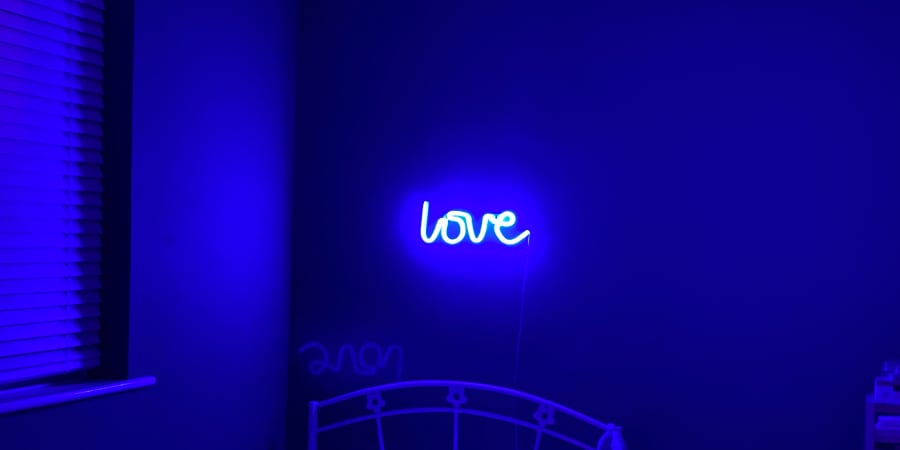
Seen, Read: 2022
- FILMS IN ALL CAPS (C if in cinema)
- Books, by author, on end date (with start date)
Here’s my list for 2022:
In the spirit of Steven Soderbergh’s media list, SEEN, READ 2022, I decided to pull my own list together, seeing as I had the data in Letterboxd and Goodreads. I’ve tweaked the key of types of media he uses, since I don’t go to the theatre or watch any TV of note:
- FILMS IN ALL CAPS (C if in cinema)
- Books, by author, on end date (with start date)
It was a fun hour reminding myself what I took in last year.
- 03/01: THE SUICIDE SQUAD
- 10/01: THE KID DETECTIVE
- 11/01: SALT
- 15/01: DON’T LOOK UP
- 19/01: Saltwater, Jessica Andrews (16/01)
- 23/01: WRATH OF MAN
- 26/01: SAVE YOURSELVES!
- 29/01: LICORICE PIZZA
- 01/02: DEEP RISING
- 02/02: THE EMPTY MAN
- 04/02: THE BROTHERHOOD OF SATAN
- 11/02: NOMADLAND
- 13/02: A Patchwork Planet, Anne Tyler (20/01)
- 16/02: Men, Women and Chain Saws, Carol J. Clover (02/02)
- 17/02: FREAKY
- 18/02: THE FRENCH DISPATCH
- 20/02: A BOY CALLED CHRISTMAS
- 23/02: Diary of a Film, Niven Govinden (10/02)
- 26/02: CLAPBOARD JUNGLE; APPLES
- 28/02: THE SPARKS BROTHERS
- 04/03: Heartburn, Nora Ephron (26/02)
- 07/03: Uncanny Valley, Anna Wiener (26/02)
- 09/03: KATALIN VARGA
- 11/03: CONVOY; I Am Sovereign, Nicola Barker (07/03)
- 12/03: ADVENTURELAND; JOHN WICK
- 19/03: Paperbacks from Hell, Grady Hendrix (13/03); Can’t and Won’t, Lydia Davis (14/03)
- 21/03: Things I Don’t Want to Know, Deborah Levy (21/03)
- 25/03: COLUMBUS
- 26/03: The Cost of Living, Deborah Levy (22/03)
- 27/03: THE BATMAN
- 31/03: THE CAVE
- 01/04: THE CONSEQUENCES OF LOVE
- 02/04: TITANE
- 09/04: The Answer to Everything, Luke Kennard (06/04)
- 10/04: 9: LIVES OF A WET PUSSYCAT
- 15/04: Real Estate, Deborah Levy (12/04)
- 17/04: Nod, Adrian Barnes (10/04)
- 18/04: THE MATRIX RESURRECTIONS
- 23/04: ALLIGATOR; Exercises in Control, Annabel Banks (21/04)
- 24/04: JAWS 3-D
- 25/04: JAWS: THE REVENGE
- 30/04: Dead Relatives, Lucie McKnight Hardy (25/04)
- 01/05: PIRANHA 3D
- 04/05: CROCODILE
- 05/05: Hideous Kinky, Esther Freud (02/05)
- 06/05: CRANK
- 08/05: JAWS
- 09/05: The Time Machine, H.G. Wells (06/05)
- 11/05: THE WOMAN IN THE FIFTH
- 13/05: MORVERN CALLAR
- 14/05: INTO THE NIGHT
- 17/05: BLACK CRAB; A Field Guide to Getting Lost, Rebecca Solnit (14/05)
- 18/05: EVERYTHING EVERYWHERE ALL AT ONCE
- 20/05: PALM SPRINGS
- 21/05: THE WORST PERSON IN THE WORLD
- 28/05: OSLO, AUGUST 31ST
- 30/05: RESIDENT EVIL: WELCOME TO RACCOON CITY
- 03/06: Seafood & Cocktails, Eygló Karlsdóttir (01/06)
- 14/06: THE RAPE OF THE VAMPIRE; REQUIEM FOR A VAMPIRE
- 15/06: VIDEO NASTIES: MORAL PANIC, CENSORSHIP & VIDEOTAPE
- 16/06: VIDEO NASTIES: DRACONIAN DAYS
- 18/06: DEATH ON THE NILE
- 24/06: A SNAKE OF JUNE
- 25/06: SPIDER-MAN: NO WAY HOME
- 30/06: UNDER SIEGE; Braised Pork, An Yu (28/06)
- 02/07: A FISTFUL OF DOLLARS
- 05/07: RESERVOIR DOGS
- 07/07: DEATH SPA; TRANCERS
- 08/07: BROADCAST SIGNAL INTRUSION
- 09/07: THOR: LOVE AND THUNDER
- 13/07: Material Girls: Why Reality Matters fo Feminism, Kathleen Stock (09/07)
- 14/07: FOR A FEW DOLLARS MORE
- 16/07: PULP FICTION
- 18/07: THE RUNNING MAN
- 22/07: THE GRAY MAN
- 23/07: OCEAN’S TWELVE; THE NIGHT HOUSE; Finding Meaning in the Second Half of Life, James Hollis (21/07)
- 25/07: BULL; The Spirit of Science Fiction, Roberto Bolaño
- 26/07: FOOTPRINTS
- 27/07: DEEP BLUE SEA
- 28/07: All the Dark Places, Eygló Karlsdóttir
- 29/07: DOCTOR STRANGE IN THE MULTIVERSE OF MADNESS
- 31/07: Steering the Craft, Ursula K. Le Guin (30/07)
- 01/08: STOP MAKING SENSE
- 02/08: BLACK BEAR
- 04/08: I’m Thinking of Ending Things, Iain Reid (02/08)
- 05/08: NIGHT TIDE
- 09/08: Climbers, M. John Harrison (04/08)
- 10/08: THE QUIET EARTH; UNDINE
- 11/08: DEAD SET; Demon, Matt Wesolowski (10/08)
- 12/08: LUX ÆTERNA
- 13/08: NOPE
- 16/08: PREY
- 23/08: Juliet, Naked, Nick Hornby (15/08)
- 28/08: THE BOURNE SUPREMACY
- 29/08: THE BOURNE ULTIMATUM
- 30/08: RATATOUILLE; A Moveable Feast, Ernest Hemingway (23/08)
- 31/08: JASON BOURNE
- 02/09: THE BOURNE LEGACY
- 03/09: RAIDERS OF THE LOST ARK; Every Song Ever, Ben Ratliff (15/08)
- 06/09: THE CLOVERFIELD PARADOX
- 11/09: NOBODY
- 14/09: EYES WITHOUT A FACE
- 16/09: SECONDS
- 17/09: TARGETS
- 18/09: NIGHT OF THE CREEPS
- 19/09: THE NIGHT OF THE HUNTER
- 24/09: VIRUS:32
- 25/09: DAVE MADE A MAZE
- 25/09: DON’T HUG ME I’M SCARED
- 26/09: LET’S SCARE JESSICA TO DEATH
- 27/09: FIVE DOLLS FOR AN AUGUST MOON
- 30/09: Vernon Subutex 1, Virginie Despentes (18/09)
- 01/10: STAR WARS; THE BAY
- 02/10: KILL, BABY… KILL!
- 03/10: SEOUL STATION
- 04/10: CANDYMAN (1992)
- 05/10: CANDYMAN (2021)
- 06/10: HELMUT NEWTON: THE BAD AND THE BEAUTIFUL
- 08/10: OFFSEASON
- 13/10: THE FEARLESS VAMPIRE KILLERS
- 16/10: KING KONG (1933)
- 16/10: THE CURSE OF FRANKENSTEIN
- 17/10: WEREWOLF BY NIGHT
- 18/10: CHOPPING MALL
- 20/10: STAGE FRIGHT
- 25/10: COME TRUE
- 26/10: SPIDER BABY
- 27/10: NEW NIGHTMARE
- 28/10: HALLOWEEN III: SEASON OF THE WITCH
- 05/11: ROGUE ONE: A STAR WARS STORY
- 07/11: THE UNBEARABLE WEIGHT OF MASSIVE TALENT
- 09/11: LITTLE SHOP OF HORRORS
- 11/11: The Hitchhiker’s Guide to the Galaxy, Douglas Adams (01/11)
- 15/11: THE KINGDOM
- 16/11: REAL LIFE; CLERKS
- 18/11: SPEED
- 19/11: AMBULANCE; Candescent Blooms, Andrew Hook (12/11)
- 26/11: BUGSY MALONE
- 01/12: LOGAN’S RUN
- 02/12: THX 1138
- 11/12: MAD MAX 2
- 15/12: THE HITCHHIKER’S GUIDE TO THE GALAXY
- 19/12: NATIONAL LAMPOON’S CHRISTMAS VACATION
- 20/12: SPIRITED
- 21/12: Frankenstein, Mary Shelley (05/12)
- 24/12: TOP GUN: MAVERICK
- 25/12: GLASS ONION: A KNIVES OUT MYSTERY
- 31/12: The Rats, James Herbert (29/12)
Adieu, 2022
It’s been a year of three big creative adventures: getting a new job (first in fourteen years); a family holiday in France (first to Paris for a week, then to Morzine in the French Alps); setting up my Patreon (experimenting with a patrons-only podcast).
There was very little fiction writing, but plenty of reflective writing, a lot of films (131), and some books (26 of which were fiction).
In time-honoured fashion, here are my favourite discoveries of 2022, in chronological order of publication or release.
Favourite books of 2022
- The Hitchhiker’s Guide to the Galaxy (1979), Douglas Adams
- Climbers (1989), M John Harrison
- A Patchwork Planet (1998), Anne Tyler
- Nod (2012), Adrian Barnes
- I’m Thinking of Ending Things (2016), Iain Reid
- The Spirit of Science Fiction (2016), Robert Bolaño
- Saltwater (2019), Jessica Andrews
- Braised Pork (2020), An Yu
- Dead Relatives (2021), Lucie McKnight Hardy
- Seafood & Cocktails (2021), Eygló Karlsdóttir
Favourite films of 2022
- Stop Making Sense (1984), dir. Jonathan Demme
- Morvern Callar (2002), dir. Lynne Ramsay
- The Consequences of Love (2004), dir. Paolo Sorrentino
- Oslo, August 31st (2011), dir. Joachim Trier
- Columbus (2017), dir. Kogonada
- The Empty Man (2020), dir. David Prior
- Palm Springs (2020), dir. Max Barbakow
- Undine (2020), dir. Christian Petzold
- The Sparks Brothers (2021), dir. Edgar Wright
- Top Gun: Maverick (2022), dir. Joseph Kosinski
Time to wrap this year up and store it with all the others.


Films, dreams, fiction and writing
I’ve come to think that films are intrinsically linked to my writing practice, but I’m worried my film-watching habit is more of a distraction than an inspiration. Films are like dreams, and the good ones are endlessly interpretable vessels for the unconscious mind. How could that not be useful to a writer? Or am I kidding myself?
What I really want is to discover films and fiction that directly feed into writing my work-in-progress. When I pick a film, sometimes it’s based on an unconscious desire or feeling that needs surfacing, and often it’s linked to the last thing I watched or read, perhaps an actor, or a theme. Even bad films have something for me, a single image or a line of dialogue. If I paid more attention, maybe I could use films more actively in my writing. The scenes I write look like a film in my imagination. Well, rehearsals on a film set, let’s say, with a sparse, mostly improvised script, a confused director, and infinite film for lots and lots of takes. Sometimes details from films I’ve seen will slip in, and an unseen costume designer will amend an item of clothing, or a casting director will change an actor’s face. Dreams definitely get added too. Dreams are like surreal short films loaded with my deepest desires and fears.
What I’m saying is, I want to better understand how films, dreams, fiction and writing are connected. I hope I can make watching films a more conscious part of my writing practice, but perhaps my film habit will turn out to be more of a drag than inspiration. I don’t know. I want to experiment.
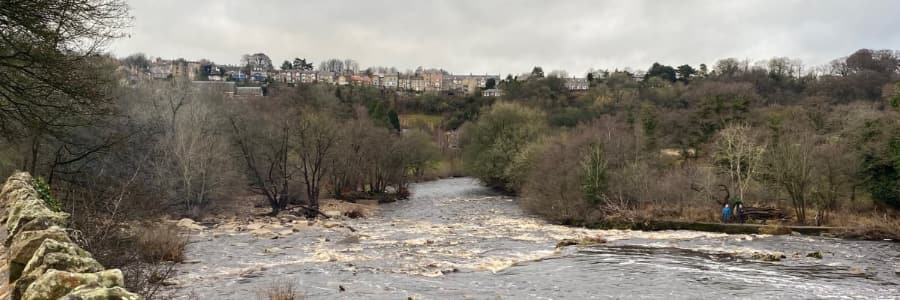
Farewell, 2021
As 2022 comes into view upriver, the final days of 2021 flow past, and I couldn’t pass up the chance to reflect on what I’ve read, watched and written this year. (Okay, reflect is a strong word, but it’s been a difficult Christmas, and I’m very tired.)
In books new to me, I opened the year with Ali Smith’s wonderful Autumn, and if my favourite books are like stepping stones on this river metaphor I’m in danger of drowning in, from there I went to An Awfully Big Adventure (Beryl Bainbridge), The Cost of Living (Deborah Levy), Clothes, Clothes, Clothes… (Viv Albertine), Redhead by the Side of the Road (Anne Tyler), Boy Parts (Eliza Clark), Hotel du Lac (Anita Brookner), The Shooting Party (Isabel Colegate), and The Glass Hotel (Emily St John Mandel).
I’m not much of a re-reader, but I got caught in some reading ruts this year, and I found writerly solace in returning to Joyland (Stephen King), Annihilation (Jeff Vandermeer), and Tinderbox (Megan Dunn).
Films. Oh-so-many films. Out of [165 films watched in 2021(https://letterboxd.com/michaelwalters/films/diary/), I gave 39 of them a rating of 5/5, and of those, my top 10 favourite discoveries, in chronological order of being made, are:
- Blow-up (1966)
- Performance (1970)
- Klute (1971)
- The Long Goodbye (1973)
- Blue Velvet (1986)
- Lost Highway (1997)
- Triangle (2009)
- Riders of Justice (2020)
- Pig (2021)
- Dune (2021)
And because this image blows my mind, here are all 165 from Letterboxd, in reverse order of watching:
Finally, in my writing, I started the year with 25,000 words of a new novel, and I end the year with 22,000 words of a new novel. But I’ve already written enough about that.
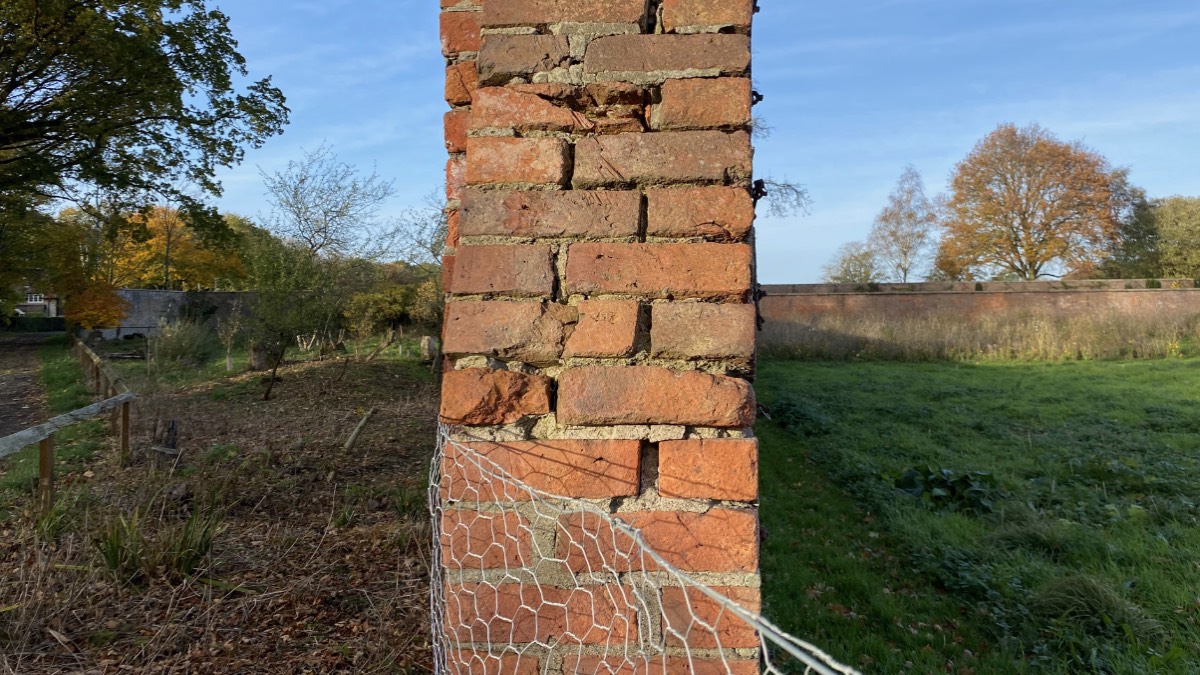
The great adjustment
Between January 2018 and December 2021, I watched 569 films. I know this because I track the films I watch on Letterboxd. That’s a lot of films. Not as many as more serious cinephiles, but a tremendous amount for someone who actually wants to be a novelist and not a filmmaker. I‘ve watched 157 films this year so far, which is on average fifty minutes a day, the length of a session of psychotherapy.
There was a gradual increase—2015 (11), 2016 (34), 2017 (61), 2018 (140)—and it’s linked to submitting my novel-as-dissertation in September 2017. After that, I needed to get away from writing, so I discovered horror film podcasts, and started a completely different adventure. I told myself that it was useful, which it was, to understand how the great (and not-so-great) films worked, thinking about story, narrative, dialogue, character arcs, all that good stuff, but looking back, I should have disengaged earlier and brought that knowledge back to my writing.
When the pandemic hit, and I was stuck working at home in a new job, with a constant newsfeed of virus fears, Trump and Brexit, I doubled down on films as a coping mechanism. (I know I keep going over this, but I think a lot of us are going to be dealing with a form of PTSD around the pandemic experience for some time to come.) I stopped reading for pleasure, partly because I lost my commute, and partly because I could feel a pressure building in me to be writing the next thing. I could watch a whole film in a ninety-minute evening slot and tick it off a list, but a novel was a longer undertaking, over several days, taking up valuable headspace that I could be using for writing. I would pick up a book, and quickly have to fight the urge to scan it, study it, and jump to the end. This was reading without engagement. I was still reading novels, but in a begrudging, desperate, manic, miserable way.
Films made me feel better in the world. Books made me feel worse. Films immerse you through image, sound, story and the fact you have to watch it for as long as it lasts, like a fairground ride. This intensifies the experience and heightens emotions, so it is closer to real life. I love that. But reflecting on a film is hard while you are watching it because it is still happening to you. It’s quite an invasive experience. It can feel overwhelming.
Books, on the other hand, give the control to the reader. A reader can be distracted by a knock at the door, read sentences a second or third time, look out of the window and daydream, recall a memory, read faster or slower, skip over a stressful scene, or even read the ending first. They can make notes in the margins and write in a notebook. You are immersed in the world of a book, but the book doesn’t demand your undivided attention. Books are a very forgiving companion. (I heartily recommend the chapter on reading in The Art of Rest, by Claudia Hammond.)
Here’s the heart of the matter for me: I can’t write without reading. To write, I need the written word as nourishment, and for me to feel nourished, I need to read slowly, with curiosity and my mind engaged.
This realisation, which is completely obvious on the surface, arrived because, in thinking about 2021 and what I might do differently in 2022, I looked back at the books I had read, and the films I had watched, and knew there needed to be an adjustment. I’m out of balance in how I get my story fix.
After four years of my adventure in films, I’m starting the great adjustment—fewer films, more books, and getting reacquainted with the gentle art of reading.
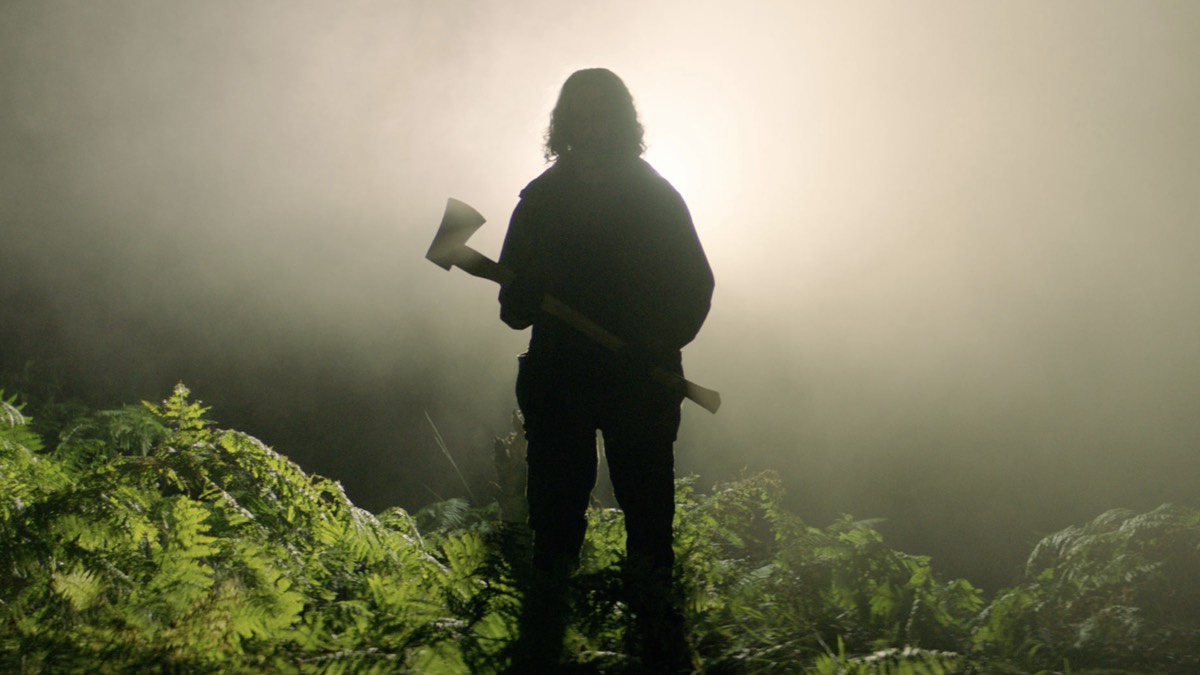
In the Earth (2021)
Director: Ben Wheatley
And so we arrive at the final film of my 2021 #31DaysofHorror, Ben Wheatley’s In the Earth. Wheatley is always interesting, and Kill List is a masterpiece, so I was happy to see him return to folk horror. He does a particular type of British awkwardness like nobody else (see Happy New Year, Colin Burstead), and that tone is present in spades here.
Martin arrives at a woodland camp controlled by the government during a deadly pandemic. He is looking for an ex-colleague, scientist Olivia Wendle, who is doing research deep in the woods. It’s a two-day hike to reach her camp, so he needs the help of park guide Alma, who tells him about the legend of the woodland spirit Parnag Wegg. They are attacked in the night, and helped by Zach, a man who lives in a makeshift camp nearby, but when he claims the trees talk to him, they begin to suspect his help comes at an awful price.
It’s a fascinating, horrible, blackly funny film about Covid, nature, group dynamics, and how humans exist in relation to other forms of life. Olivia and Zach are abusive parental figures, and Martin and Alma are trapped in their co-created psychosis. Zach has a straightforward manner that barely hides his intrinsic brutality, while Olivia’s scientific method quickly devolves into cult-speak and witchcraft. Both want to use Martin’s niceness and open-mindedness to speak to the woods through the pleasingly spooky altar stone, but it’s the pragmatic Alma who is the voice of reason and eventual conduit to the realm beneath their feet.
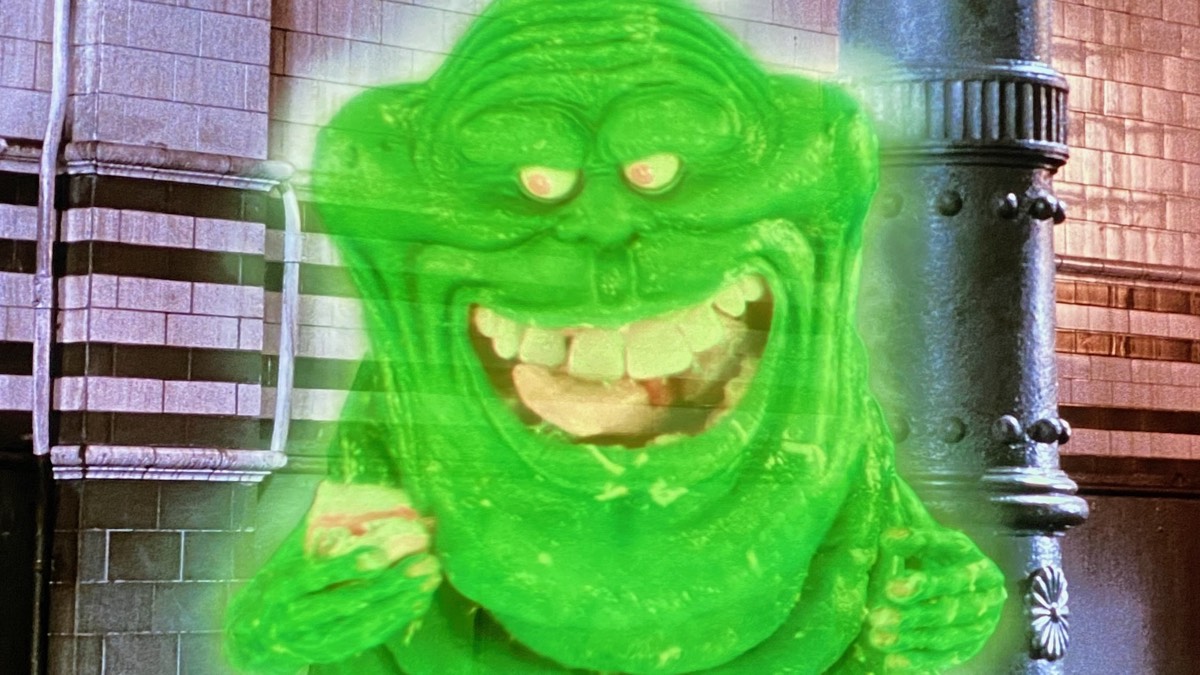
Ghostbusters II (1989)
Director: Ivan Reitman
To finish my parade of eighties sequels, I went with Ghostbusters II, which I can remember seeing in the cinema with friends back in the day. My father took me to see the original Ghostbusters, at Swansea Odeon, when I was eleven years old. I have a wonderful memory of feeling scared by the librarian ghost in the New York Public Library, and then laughing uproariously with my father as they ran outside. I’d never seen him laugh like that before, uninhibited and really enjoying himself. The whole theatre was in pieces. Magical.
Five years after defeating Gozer, Ray, Egon, Winston and Venkman are out of business. Dana works at an art museum and has a baby, Oscar. One morning she runs her pram through a sliver of red slime on the pavement. The pram takes on a life of its own, racing through traffic, and Oscar barely survives. Thinking it was a ghost, Dana asks Egon to investigate, and soon the old team have discovered a river of slime running through abandoned subway tunnels under the city. Meanwhile, Dana’s boss, Janosz, is restoring a painting of Vigo the Carpathian, an evil sorceror, who needs to possess the body of a baby at the stroke of midnight on New Year’s Eve if he is to conquer the world, and because Janosz likes Dana, Oscar becomes the target.
The four ghostbusters don’t fully rekindle the chemistry from the first film, so the first act feels awkward and not very funny. I’m surprised again at how unpleasant Bill Murray could be in the eighties; I have no idea what Dana sees in Peter Venkman. The best bits usually involve the supporting characters, Dana, Louis, Janine, and Janosz, who liven things up with some heart and good comic acting. The special effects still look pretty good, but I wish there were more ghosts, and it was always a losing battle trying to replace Ray Parker Jr’s legendary theme song, so the ghost fight scenes feel flat.

Director: Steve Miner
The #31DaysofHorror train keeps chugging along with my exhausted corpse tied to the front. Friday the 13th Part 2 is many peoples franchise favourite, and I bought it for three quid a couple of years ago, so if not now, when? Unlike Halloween, which has a heroine with a link to the killer, the camp counsellors on Crystal Lake are simply an endless supply of victims to Jason Voorhees. (I know who the killer is in the first one, so don’t Scream me.)
A couple of months after surviving the original film—the murders at Camp Crystal Lake—Alice is killed in her apartment by an unseen assailant. Five years later, a new camp has been created along the lake, and at a training week for counsellors, leader Paul tells the group the story of the slaughter, but assures everyone that Jason is dead. The next night, half the counsellors go to a nearby bar, and the ones staying behind are stalked by Jason, who is living in a self-made shack in the woods. As the night goes on, Jason picks the counsellors off one by one.
I don’t think it was done deliberately, since both films were released the same year, but just as the opening sequence of Halloween II is the final scene of the first film, Alice relives the end of Friday the 13th in dream flashbacks, before having a cat thrown at her, finding a head in her fridge, and having an ice pick pushed into her temple. The characters are all likeable, the acting is naturalistic, and the couples feel plausible, so I found myself upset as they ran afoul of Jason’s various weapons. Usually there are a few characters in these films you can’t wait to see die, but not here. This is a slasher with minimal special effects, without complex kills, and before irony. Surprisingly affecting and effective.
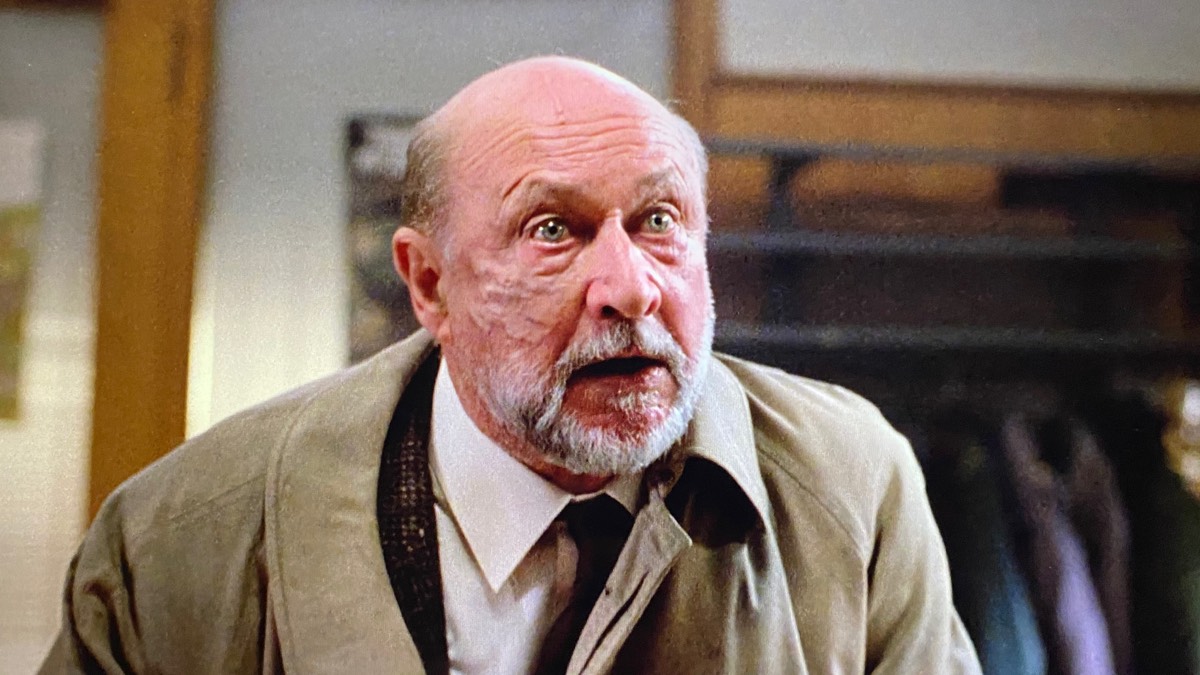
Director: Dwight H. Little
I heard someone on a podcast say Halloween 4: The Return of Michael Myers was their favourite of all the Halloween sequels. I was never a sequels guy growing up, these films were never on television in the UK, so all the Friday the 13ths, Halloweens and Elm Streets passed me by. What better way to approach the end of #31DaysofHorror than seeing what all the fuss was about?
Ten years after the Haddonfield killings, Michael Myers escapes an ambulance taking him to a new sanitarium. His psychiatrist, Dr Loomis, doesn’t know about the move until it’s too late. Loomis returns to Haddonfield to search for Myers. Laurie Strode has died in a car crash and her daughter, Jamie, is fostered by the Carruthers family. Their teenage daughter, Rachel, babysits Jamie on Halloween, but Myers wants to kill Jamie.
After twenty-seven horror films back to back, it was a relief to watch a film with no emotional stakes. The script, acting and direction are all adequate, in a television film sort of way, and Dean Cundey’s trademark wide shots are gone, but it does feel like a Halloween film, with its autumnal colour palette, pumpkins and general mood. It’s a good film to watch in the spooky season. On the downside, Michael Myers has transformed from silent creeping psychopath to a being with superhuman and possibly supernatural strength. There are moments of oddball humour, some fun set pieces, and the twist at the end is almost brilliant, but for me Michael Myers is scariest as a disturbed psychopath, not a demonic force.
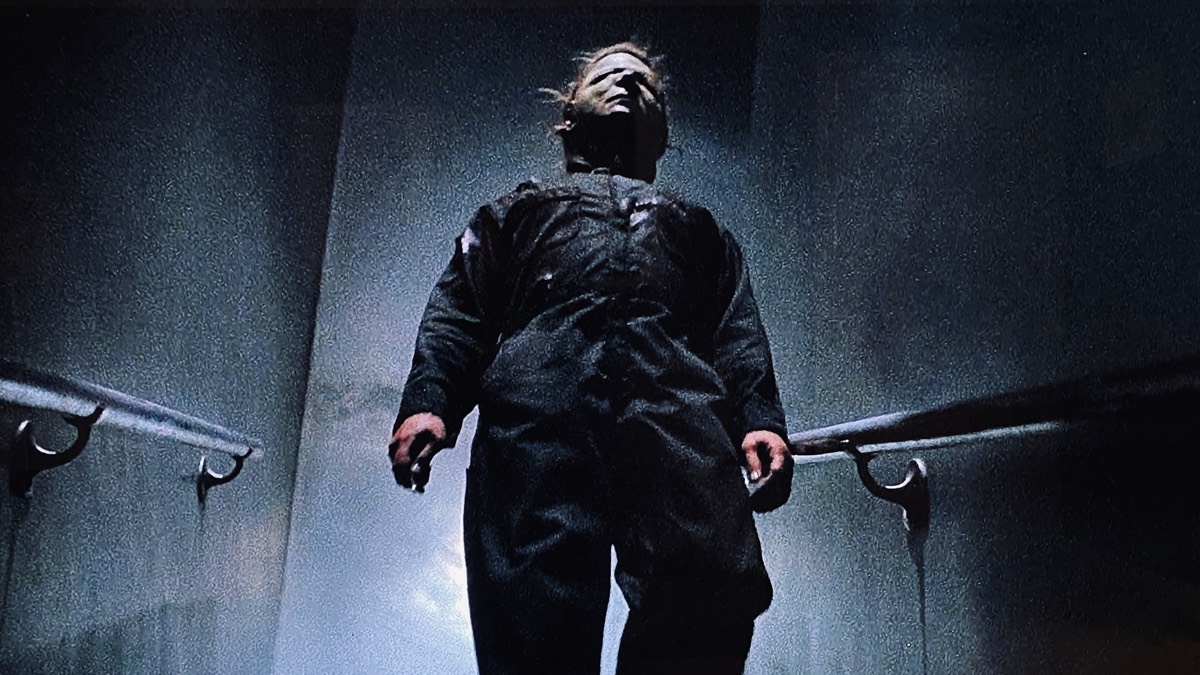
Halloween II (1981)
Director: Rick Rosenthal
The original plan was to watch Halloween Kills in the cinema, but the reviews were so awful I couldn’t bring myself to go. Instead, I went for the original sequel, Halloween II. I was surprised to see Dean Cundey’s name in the opening credits. He was cinematographer for all of John Carpenter’s early classics—Halloween, The Fog, The Thing, Escape from New York—and went on to work on massive blockbusters like Jurassic Park. I knew Halloween II was not a fan favourite, so if the script was bad, at least it would look good.
It starts with the final sequence of the original film, with Dr Loomis shooting his escaped patient, Michael Myers, and saving Laurie Strode. When Myers’ body goes missing, Loomis continues his search on the streets of Haddonfield, while Laurie is taken to hospital and sedated. But Myers wants to kill Laurie specifically because she is his sister, fostered after he killed their parents, and when he hears on the radio where she’s been taken, he stalks the hospital searching for her, killing anyone that crosses his path.
Laurie Strode seems like a less rounded character—she has no kids to look after, we don’t see her going about her day, she’s reduced to a (probably realistic) traumatised victim. The film jumps straight into the chaotic aftermath of a mass killing in a small town, which we find out is still ongoing. It’s also much darker, both literally, because there are no shots in daylight, and in its violence. Myers’s physical strength and penchant for blades and needles leads to several gruesome deaths, and in a grim aside, there’s a short scene where a mother brings her son to the hospital with a razor blade stuck in his mouth, presumably hidden in a treat. This film has a nasty streak.
But what’s wonderful about it, especially after seeing the 2018 ‘sequel’, is how much it feels like the original Halloween. Made only a couple of years later, it has the same characters, actors, and cinematographer, and even if the story is lacking in some respects, it does give a definitive ending to Laurie Strodes’ nightmare. They should have stopped here.
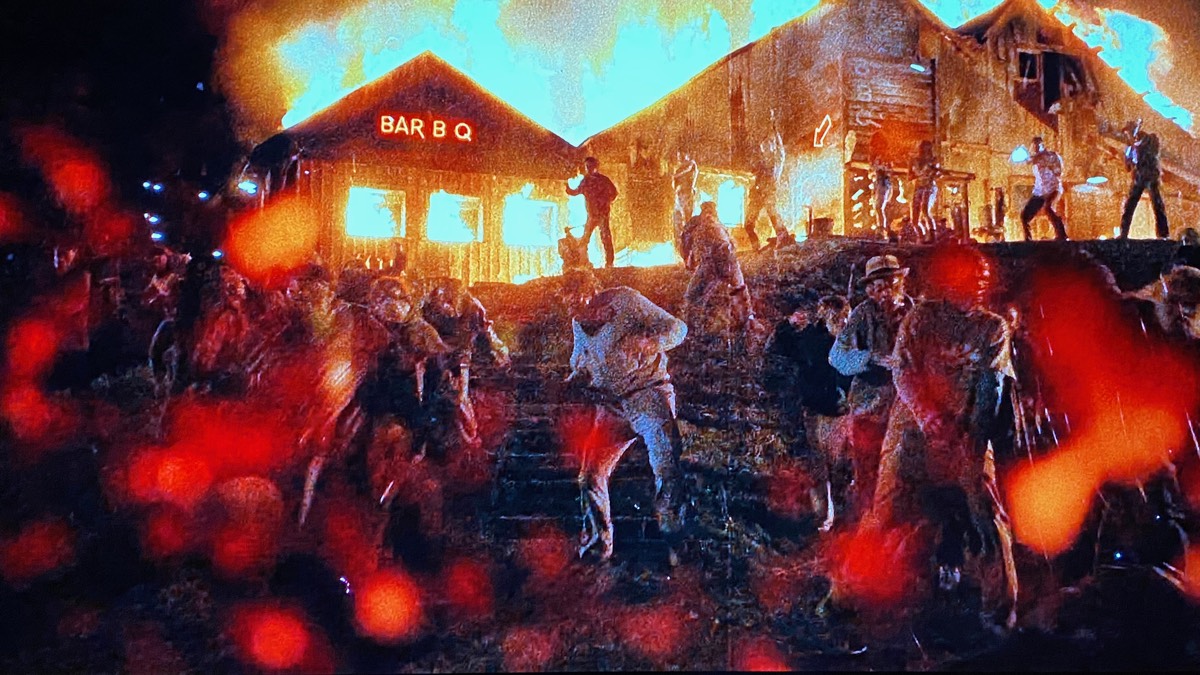
Planet Terror (2007)
Director: Robert Rodriguez
If Killer Klowns is lovingly sewn together by your coulrophilic neighbour (wait, no…), Planet Terror is a grindhouse pastiche ruthlessly tailored by a master craftsman. It’s ridiculous fun, and as much as I am not an admirer of style at the expense of story, this did make me laugh out loud at the sheer excess of it all.
Lieutenant Muldoon tries to buy a consignment of a biochemical weapon, DC2, from an arms trader for his mercenary army, but some people already infected with DC2 escape. Cherry Darling is a stripper who quits her job, runs into her ex-boyfriend El Wray, and after a car crash leaving town, has her leg ripped off by a pack of marauding flesh-eating mutants. Dr Dakota Block is planning to leave her husband for another woman during their joint shift at the local hospital, but just as he finds out, the DC2 infection hits the local population. All of these characters, and more, converge in a relentless circus of cheesy dialogue and amusingly extreme violence.
This film has everything from a rogue scientist who keeps his adversaries testicles bottled to a stripper with a machine gun for a leg. I particularly enjoyed the ‘missing reel’ that skips through a chunk of unnecessary plot to get to the action. Robert Rodriguez and Quentin Tarentino collaborated in the making of this and the Tarentino-directed Death Proof, with both films released as a double feature, Grindhouse. They weren’t a hit in 2007, but I think this is glorious fun.